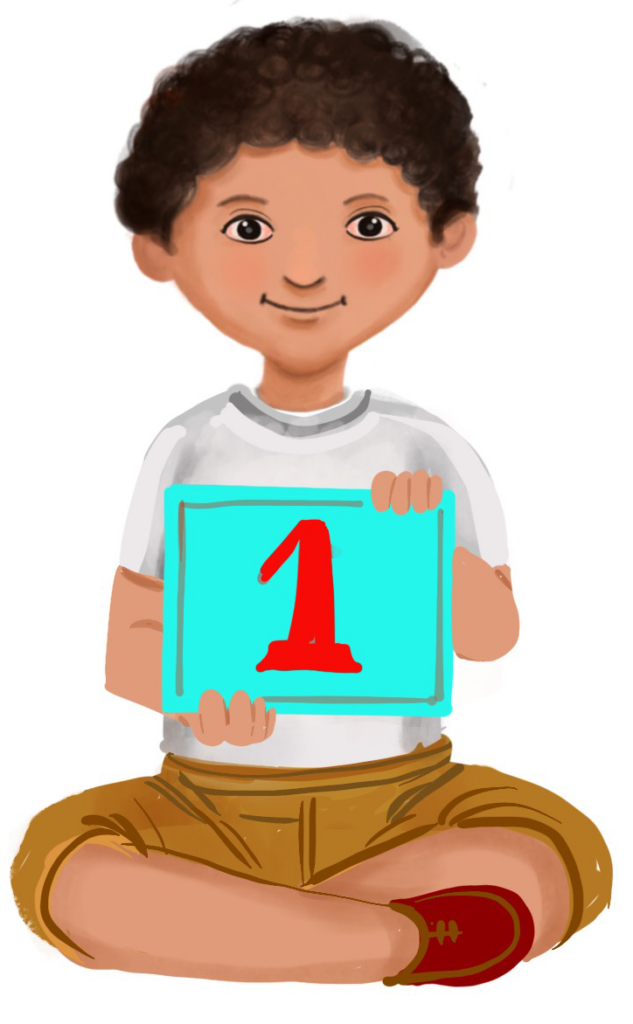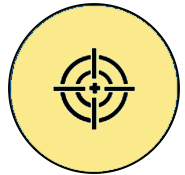
Addition 0 to 9
Week 2
Learning Outcome
Combines two groups of objects up to 9 and recounts.
 Objective
Objective
Children will be able to create and solve single-digit ‘addition’ problems and identify number bonds as pairs of numbers that add up to a given total.
 Prerequisites
Prerequisites
- Children can identify the numbers up to ‘10.’
- The teacher can have a simple check for understanding at the beginning of the lesson by asking the children to say the numbers through a flashcard.
Introduction: Revision – Addition
The teacher could begin by reviewing numbers 0 to 9 with the class. Using flashcards, ask the children to identify each number.
After giving enough revision with flashcards showing the addition of objects and numbers, the teacher could encourage the children to create and solve the addition problems through a simple activity.
Song: Together we add!
Let’s learn to add, it’s so much fun;
With numbers from zero to nine, we’ll get it done.
Zero plus one is one, Oh, it’s fine.
Count with me, it’s number time!
Chorus:
Add, add, let’s celebrate,
Combine the numbers, it’s never too late.
Count with joy, sing it clear,
Addition is something we’ll cheer!
Two plus three, can you see?
It’s five, that’s the key!
Four and one, let’s have some more,
Counting and adding, it’s never a bore.
Chorus:
Add, add, let’s celebrate,
Combine the numbers, it’s never too late.
Count with joy, sing it clear,
Addition is something we’ll cheer!
Five plus four, let’s explore,
The answer is nine, we want more!
Six and two, eight, oh, so cool,
Adding numbers is the golden rule.
Chorus:
Add, add, let’s celebrate,
Combine the numbers, it’s never too late.
Count with joy, sing it clear,
Addition is something we’ll cheer!
 Notes to the teacher:
Notes to the teacher:
- Create visual cards/flashcards with numbers and corresponding illustrations to accompany the song.
- Sing the song together, encouraging the children to clap or move to the rhythm or play the video.
- While singing, use the visuals to reinforce the concept by asking questions like “What is 3 plus 2?” and let the children respond.
Video: Song – Together we add! – Coming soon
ISL Video: Song – Together we add! – Coming soon
Activity 1: Roll and Add
Objective: To create simple addition problems through the play way method and solve them.
Importance of the activity for children:
Helps in developing:
- Cognitive skills (Problem solving-using the object provided, concentration)
- Numerical skills (Number recognition)
- Gross motor skills (Bend, pick and reach the felt board)
- Fine motor skills (Holding the marble/blocks, hand-eye coordination)
- Emotional skills (Builds confidence in numerical abilities, sense of achievement on completion builds self-esteem, pride in learning new skills)
- Social skills (Listening, Cooperation, waiting for their turn, playing together)
- Vocabulary skills (Learning concepts like ‘add,’ ‘plus,’ ‘equal to’)
Setting for the activity:
The activity can be done indoors or outdoors depending on the availability of space.
Type of activity: Group or individual activity
Preparation of activity:
The teacher may provide the required materials to the children.
Role of the teacher: Demonstrator and facilitator.
Procedure:
- Distribute the dice, drawing sheet, and colour marker pen or pencil to the children.
- Ask the children to roll the dice and note down the number on the dice on the drawing sheet.
- Let the children roll the dice one more time, and this number could be written with a plus symbol.
4+5= (The children have created one addition sum.) - Encourage the children to create as many problems as possible. (At least five different problems)
- Give them time to complete the addition.
- Once completed, have a discussion about addition with all the children.
Observations:
The teacher observes the children during the activity:
- To find if the children are able to create addition problems and add the two numbers correctly
- To provide any assistance, if required and
- Notes down the feedback to be given.
Suggested Variations in the activity:
- The teacher could provide playdough to create an additional problem instead of writing it on the paper.
- The children could be encouraged to use any available objects to count instead of writing it on the paper.
- The children could be encouraged to make any objects according to the number they get on the dice.
- Since dice are used to note down the number, the total may exceed 10. Let the children try adding the numbers they get.
Conclusion:
Children would be able to create simple addition problems using rolled numbers and solve them.
Video: Roll and add – Coming soon
ISL Video: Roll and add – Coming soon
Activity 2: Number Bonds
Objective:
To help children understand how different pairs of numbers can combine to form a total sum of a number. This helps them grasp the concept of addition and number bonds.
Importance of the activity for children:
Helps in developing:
- Cognitive skills (Problem solving, concentration, memory recall)
- Numerical skills (Number recognition)
- Gross motor skills (Bend, write)
- Fine motor skills (Holding the pencil, hand-eye coordination)
- Emotional skills (Building confidence in numerical abilities, sense of achievement on completion builds self-esteem, Pride in learning new skills)
- Vocabulary skills (Learning concepts like ‘bonding of numbers’, ‘plus’, ‘equal to’)
Preparation of activity:
- The teacher prepares number bond templates.
- Materials include paper, markers, and simple number bond templates. These can be pre-prepared or created during the lesson.
Procedure:
- The teacher explains through a video what number bonds are, followed by demonstrating more examples on the board. (For example, the teacher picks 9 beads. The beads are arranged in different ways that add up to 9. Such as 1 + 8 = 9, 2 + 7 = 9, etc. After arranging, each time the teacher writes the addition statement on the board or on a chart)
- Provide each student with a number bond template, paper, and markers or pencils and the counters of the choice of their number. For example, if the child chooses 5, then 5 counters are to be provided.
- Ask children to fill in the number bond boards by choosing pairs of numbers that add up to 5. For example, 4 + 1 = 5, 3 + 2 = 5, etc.
- Children can write down the addition statement they create using their number bonds. Encourage them to create at least five different problems.
- Once children have completed their number bond boards, discuss the answers as a class. Review the different pairs and how they combine to make 5.
Observation:
- Can the child show different pairs of numbers that add up to the chosen total?
- Can the child correctly write and understand simple addition sentences (e.g., 2 + 3 = 5)?
Suggested Variation in the activity:
- Number Bond Puzzles: Create puzzles where children match number pairs to a total sum of 9. For example, have cards with numbers, and children match them to create correct sums.
- Group Work: Have children work in pairs or small groups to create number bonds and compare their findings with other groups, promoting collaborative learning and discussion
Conclusion:
Children learn to identify and create different pairs of numbers that sum up to 9, reinforcing their knowledge of number relationships.
Video: Number Bonds – Coming soon
ISL Video: Number Bonds – Coming soon
Worksheet: Number Bonds – Coming soon
Worksheet: Number Bonds (Enlarged) – Coming soon
Assessment:
The teacher can give the practice worksheet to the children, which can be followed by an assessment worksheet.
Practice Worksheet: Number bonds – Coming soon
Practice Worksheet: Number bonds (Enlarged) – Coming soon
Assessment Worksheet: Number bonds – Coming soon
Assessment Worksheet: Number bonds (Enlarged) – Coming soon
Check list for teacher:
| Activity | Yes | No | Sometimes |
| Children can: | |||
| Identify single digit numbers | |||
| Add single digit numbers | |||
| Create addition problem | |||
| Combine two single digit numbers and perform addition | |||
| Solve the problems in the given time | |||
| Do the activity independently | |||
| Express verbally and through actions, expressions or gestures |
Home Activity
Count the pictures and add.
Worksheet: Count the pictures and add – Coming soon
Worksheet: Count the pictures and add (Enlarged) – Coming soon
Cross-Curricular Connection:
- In Art class: Drawing activity
- Instruct the children to choose any two numbers from 0 to 9.
- Ask them to draw that many objects for each number with coloured crayons.
- Let them do the addition by counting the objects drawn for both numbers.
- Encourage the children to bond the numbers in different ways to get the same total of the two numbers chosen.
- For each bond let them draw the objects
- Encourage creativity and emphasize the idea of combining groups of objects.
- In physical education class:
- Play a group game.
- Give an addition sum, e.g., 3 + 4. The children have to group in 3s and 4s and join together.
- Stand in line and count 1, 2… 7. So 3+ 4 = 7
- Let the group of 7 children regroup to stand and count to 7. E.g., 5 children in one group and 2 in another group.
- Children learn the bonding of numbers through a play-way method.
Adaptations for addressing learner variability: Adaptations and strategies – Coming soon
Teacher Resource Document – Coming soon
| Source and Attribution of images: All images used in the above Assets and Aids are originally created. |
| This digital material has been developed by the Sri Sathya Sai Vidya Vahini Inclusive Education Project, a unit of Sri Sathya Sai Central Trust, Prasanthi Nilayam, as a collaborative offering in the service of our nation. |